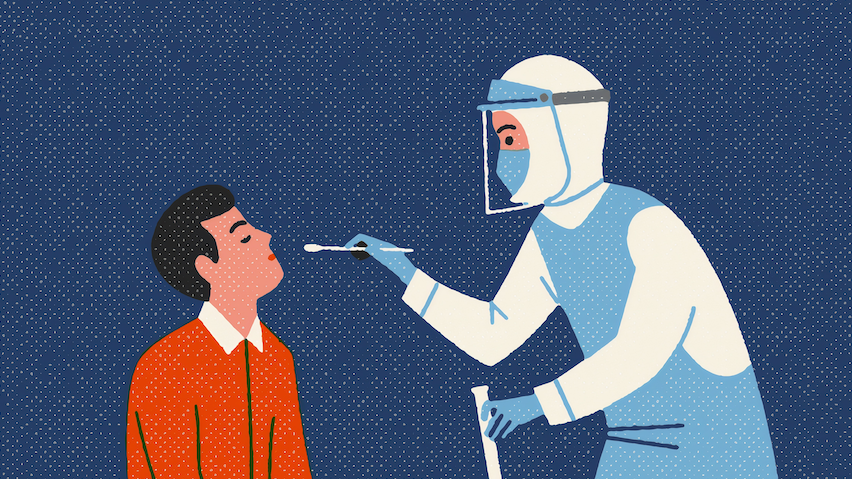Teton County Health Department released a “Roadmap to Recovery Plan” Tuesday, and one thing is clear: any path forward comes with costs.
As the county softens its COVID-19 emergency response, people may be eager to throw off masks and catch up with friends. But even though a stay-at-home order has expired, the health department urges caution.
“As we know, a person is infectious up to 48 hours before they show symptoms, so continuing physical distancing and wearing masks is super important,” said Jodie Pond, director of the Teton County Health Department. “That hug you might give a friend, or sitting close to them at a dinner party may be problematic.”
Pond said people should continue strict hygiene practices: frequently washing your hands, regularly disinfecting high-touch surfaces, avoiding touching your face, and staying home when you’re sick.
Even if you feel fine, health officials say it is still prudent to behave as if you are infected with the new coronavirus. “There is the whole other group of people we are seeing that are asymptomatic but positive and are spreading it unknowingly,” Pond said.
The county’s recovery plan offers a kind of middle ground for mitigating risk. The plan includes three phases—“response,” “stabilization,” and “recovery.” The current stabilization phase could last 10 to 14 weeks, during which time some businesses can open, and some health orders will be lifted.
Within those phases, four levels of color-coded public health guidance assess health risks: red, orange, yellow and green. The county is now deemed to be generally at the orange, or moderate, risk level, except for high-risk individuals. Some businesses are still in the red zone, while others have moved to orange.
Pond said the move from red to orange is based on metrics her office is watching closely. As of May 7, there were 67 confirmed and 31 probable COVID cases with 89 recoveries and one death. Meanwhile, the county’s per capita infection rate was 285 cases per 100,000 people, the second highest in the state. (Fremont County, reporting 155 confirmed cases, assumed the top position with 324 cases per 100,000 residents.)
Despite Teton County’s high per capita infection rate, community spread is stable and the positivity rate, or the number of people tested whose results have come back positive, is on a decline. It has decreased from 14 percent last month to 8.2 percent, a number that is still twice as high as the state’s overall rate. (Epidemiologists watch this statistic closely because it indicates whether communities are casting a wide enough net or only testing their most at-risk individuals.)
Meanwhile, ramped up testing—including free testing for uninsured or unemployed people who have even mild COVID symptoms—has not resulted in a spike in cases or additional hospitalizations. The percentage of COVID patients requiring hospitalization has hovered between 16 and 20 percent.
“That hug you might give a friend, or sitting close to them at a dinner party may be problematic.”
– Jodie Pond, Teton County Health Department
Under Teton County’s variances to statewide public health orders, some businesses in the red zone remain closed. Dr. Travis Riddell, Teton District health officer, received state approval April 29 for variances that keep gyms, beauty salons, massage parlors, tattoo and piercing shops, and similar services closed until May 11.
During a press conference Friday, Riddell outlined reasons for the extended closures. He said Teton County is “epidemiologically different” than other places in Wyoming. “As a mountain resort community, we have much more in common with other resort communities, which in turn also look more like other places in the country outside of Wyoming—the East Coast and the West Coast in particular.”
Riddell said Teton County’s caseloads and epidemic curve resemble those areas more than other parts of the Cowboy State. He also has pointed to Teton County’s service-based, person-to-person economy, which raises the probability of disease transmission here and differs from the dynamics in rural counties across the state.
Impacts TBD
Amy Dowell, owner of The Painted Lady tattoo studio, took the continued restrictions in stride. The pandemic hit during her planned maternity leave, so she had money saved. However, without that reserve, she says the loss of revenue would have been financially devastating. And she is worried about the future.
“I think it will take time to see the full impact on my business,” Dowell said. “My income is dependent on people’s disposable income. I have had quite a number of clients have to cancel or reschedule sessions due to loss of income, loss of employment, inability to travel, and health concerns for themselves or family members.”

Tattoo artist Amy Dowell is concerned about her business because it hinges on a healthy economy—people’s ability to spend disposable income. Meanwhile, she says staying open will depend on maintaining supplies that have become scarce due to the COVID-19 pandemic, such as gloves, masks and sanitizer. (Meredith Richardson)
Anna Olson, president and CEO of the Jackson Hole Chamber of Commerce, says dealing with the pandemic has been exhausting for business owners. They face a slow path forward and “the pressure of maintaining a business is enormous.”
Businesses are concerned not only about staying afloat, but also keeping staff and customers safe. Dowell is more prepared than some to create a safe-as-possible environment for her clients. “Doing what I do already requires a lot of knowledge in pathogens and cross-contamination. I plan on taking all of the precautions outlined by the health department for reopening, as well as some additional ones that I feel will bring added safety and security for myself and my clients.”
She does not feel cavalier. Anxieties about her clients’ health, her health, and how her work could affect her family “all weigh on me quite heavily,” Dowell said. She is also concerned that once tourism kicks back into gear, COVID cases could increase.
Olson said that is a worry the chamber is watching closely. “We know there will be some change in the statistics as there is more movement in the valley, and with people being closer to each other,” she said. “But we are still unsure about the effects of that.”
With each new phase of the county’s recovery comes costs and benefits. The high-risk, stay-at-home phase of community response had severe economic consequences, but it minimized health risks. As the county edges toward more reopenings, the economy may see improvement, but other costs remain.
For one, there will be a financial toll associated with increased testing and contact tracing. The health department received funding from the Community Foundation of Jackson Hole to help ramp up those efforts. But Pond is concerned that health departments are missing the funding they need from the public sector. So far, federal relief packages have, rather ironically, earmarked little for public health amid a global pandemic. “It has been demoralizing,” she said.
Pond said there will also be a human cost: “We expect to see an increase in cases and an increase in deaths.”
There is no way around this sobering reality. Until there is a vaccine or the community reaches herd immunity, returning to normal is a distant notion. “Can we lower morbidity and mortality? Yes,” Pond said. But reducing disease and death will take community vigilance. People and businesses must follow health recommendations and guidance, she said.
Meanwhile, there is no guarantee the infection rate won’t surge again. Dr. Anthony Fauci, a steady voice on the White House’s coronavirus task force and head of the National Institute of Allergy and Infectious Diseases at the National Institutes of Health, told CNN that a second wave of the coronavirus is “inevitable.”
The severity of the second wave will depend on countermeasures the nation puts in place now. Testing for the virus, tracking cases, and isolating every infected American will be key factors, Fauci said. If states lift restrictions too early, he predicted a backward slide that could result in more deaths than currently forecasted.
Coping with this fluid landscape is challenging. For Dowell, having access to proper supplies is crucial given the nature of her business. “Simple things like isopropyl alcohol and paper towels are hard to find anywhere, and they are a necessity with what I do,” she said. Not to mention gloves, masks, disinfectants, and sanitizer. Those all add up to business expenses, made more expensive by price gouging. A lack of supplies “could force me to close again once I reopen,” Dowell said.
As Teton County businesses cautiously reopen, guidelines for high-risk individuals do not change. No matter what color-coding is present, those who could develop serious illness from COVID-19 are advised to stay home.
Pond told her 80-year-old parents to hunker down for the long haul. “I tell them, ‘No, you are not participating in society until there is a vaccine.’”





